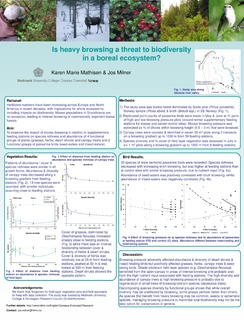| dc.contributor.author | Milner, Jos M. | |
| dc.contributor.author | Mathisen, Karen Marie | |
| dc.date.accessioned | 2010-12-21T13:07:29Z | |
| dc.date.available | 2010-12-21T13:07:29Z | |
| dc.date.issued | 2010-03 | |
| dc.identifier.uri | http://hdl.handle.net/11250/134794 | |
| dc.description | Posteren ble presentert på Sustainable Conservation: Bridging the gap between disciplines i Trondheim 15.-18. mars 2010 | en_US |
| dc.description.abstract | Herbivore numbers have been increasing across Europe and North America in recent decades, with implications for whole ecosystems including impacts on biodiversity. Moose populations in Scandinavia are no exception, leading to intense browsing of commercially important boreal forests. We examined the impact of moose browsing on species richness and abundance of 4 functional groups of plants (grasses, forbs, dwarf shrubs and canopy trees) and 2 functional groups of passerine birds (seed-eaters and insect-eaters) along a browsing gradient from sites of heavy browsing around supplementary feeding stations to light browsing at control sites. Both positive and negative effects were recorded. | en_US |
| dc.language.iso | eng | en_US |
| dc.publisher | Sustainable Conservation: Bridging the gap between disciplines | en_US |
| dc.subject | herbivores | en_US |
| dc.subject | økosystemer | en_US |
| dc.subject | ecosystems | en_US |
| dc.subject | elg | en_US |
| dc.subject | alces alces | en_US |
| dc.subject | birch | en_US |
| dc.subject | pine | en_US |
| dc.subject | trophic cascade | en_US |
| dc.title | Is heavy browsing a threat to biodiversity in a boreal ecosystem? | en_US |
| dc.type | Conference object | en_US |
